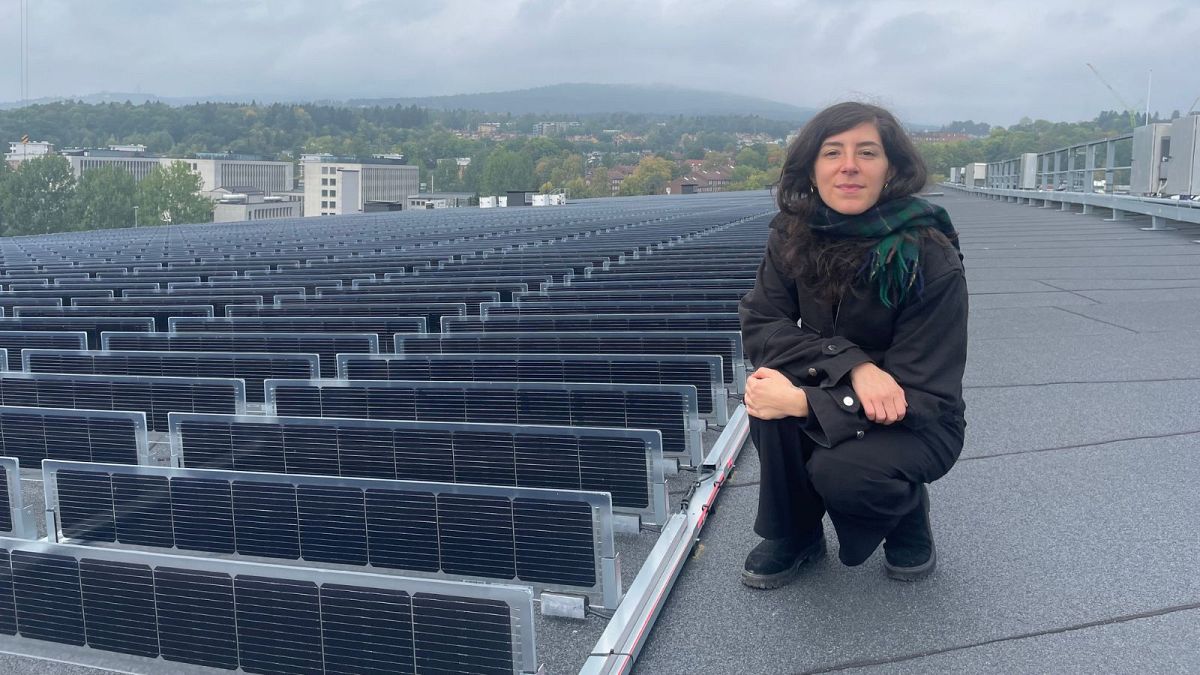World
The view from the world’s biggest vertical solar rooftop

Vertical solar panels are proving to be a new solution for northern regions, yielding 20 per cent more energy than traditional panels.
Norway’s national football stadium carries a lesser-known star attraction: 1,242 solar panels stretching across the roof.
These are not traditional flat roof panels. The mini, square-shaped solar panels have two key features that distinguish them from those typically seen on buildings: they are bifacial, meaning they have two active sides, and they are installed vertically.
In June 2024, Ullevaal Stadium in Oslo became home to the world’s largest vertical solar panel installation on a roof, placing the stadium at the forefront of renewable energy innovation.
At first glance, the panels look fragile, and one might worry about stepping on them. But during a visit to the stadium, we quickly learn that they are incredibly efficient in generating solar power.
Ullevaal Stadium has an ambitious goal of generating at least 250,000 kilowatt-hours (kWh) of electricity annually, around the energy needed to power 71 households for a whole year.
These bifacial vertical solar modules are the only solution capable of achieving these figures, particularly in colder, less sunny regions. If the goal is achieved, the stadium will enlarge its installation to other sides of the roof.
What is the difference between vertical and horizontal solar panels?
It might seem counterintuitive not to tilt solar panels to face the sun directly, as installations are usually angled to align with the latitude in which buildings are located. However, recent studies show that bifacial vertical photovoltaic (PV) panels can outperform traditional models in terms of energy generation.
Scientists at the Dutch research organisation TNO examined why this is the case. It’s not because bifacial solar panels have two identical but opposite sides, but because traditional tilted PV panels tend to overheat when the sunlight is too strong.
“Lower operating temperatures correspond to increased performance,” explains Bas van Aken, a scientist at TNO.
“PV panels lose about 1 per cent of performance for every 2 to 3 degrees Celsius they warm up. Tilted roof PV systems can easily heat up by 50 degrees, while open-field PV systems see panels getting up to 25 to 30 degrees warmer than the ambient air,” he adds.
Vertical solar panels can yield up to 20 per cent more energy, making them valuable in climates with harsh and dark winters, where maximising energy production during shorter days is crucial.
At Ullevaal Stadium, the panels face the sun directly, with its PV system oriented north-south to capture light during peak times in the early afternoon. “We chose this orientation because we want to produce more energy in winter when electricity prices are higher,” says Lise Kristin Sunsby, the stadium’s real estate manager.
The stadium uses vertical panels developed by the Norwegian startup Over Easy Solar, which had piloted its invention on other buildings in Norway before securing the contract to cover the football arena’s roof.
Trygve Mongstad, CEO of Over Easy Solar, previously worked as a solar panel installer and realised that traditional PV can be tricky to fix on roofs, being both heavy and time-consuming to install. With his new vertical panels, the process is lighter, reducing costs and making it easier to complete: “It took us four days to install all these units,” says Mongstad.
Vertical PV panels also benefit from the albedo effect, where snow falling between the rows reflects sunlight onto the panels, boosting energy yield.
In contrast, horizontal or tilted panels require a great deal of maintenance and cleaning after snowstorms in the northern regions, or sandstorms in southern climates, both of which can block energy production for entire days.
Over Easy Solar now has 30 solar installations across 11 European countries, including Spain and Switzerland. The company observed how its product performs in southern regions as well. “It performs well, especially when paired with white coloured roofs, which is highly reflective and which are common in hotter, sunnier countries to reduce heat absorption,” notes Mongstad.
What is the future for vertical solar panels?
The transformation of public venues into energy producers is becoming increasingly widespread.
The O2 Arena in London, Europe’s largest indoor venue, and Turkey’s Galatasaray Stadium are examples of how entertainment venues are moving towards sustainability by integrating renewable energy solutions into their operations which also help them reduce costs.
As cities seek to reduce their carbon footprint, the demand for more efficient, space-saving solar energy solutions is growing beyond just public venues.
These panels can also be combined with green roofs, which help cities absorb CO2 and become more environmentally friendly – a feature that is not possible with tilted panels. In Germany, solar balconies – small panels installed on apartment terraces – are becoming popular as a way to offset individual energy consumption.
Vertical PV panels can also find a place in noise barriers along highways, or on farms. “The small [vertical] footprint is favourable, allowing sufficient access to the crops between the rows… it reduces shading between rows… and it also intercepts less rain compared to regular tilted systems,” explains van Aken, who is working on an agriphotovoltaic pilot project in The Netherlands.
Vertical solar panels are an emerging technology that is likely to play a significant role in the energy transition and help the EU achieve its binding target of 42.5 per cent of renewable energy by 2030.
According to the European Commission, integrating this technology can further help Europe fix its energy price swings and provide more energy security.
However, vertical PV is not part of a ‘winner takes all race’. Mongstad suggests that there will not be a switch from horizontal to vertical PVs any time soon; this change is more likely to occur when older installations reach the end of their lifecycle, at which point companies could replace the old panels with vertical ones.
Only a mix of inclinations – from vertical to horizontal, and orientations from east to west and south to north – will help generate constant energy throughout the day and further stabilise energy prices across the continent.










